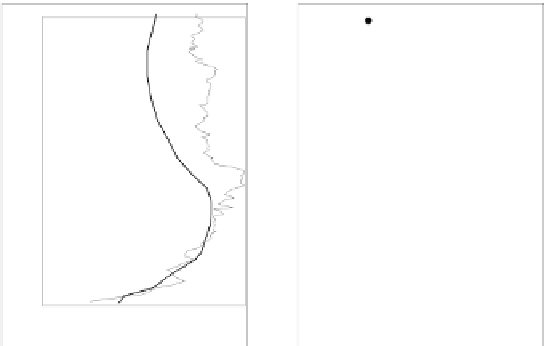Environmental Engineering Reference
In-Depth Information
above case, of both ground and upper air, show deviations between the model and
observations for ground level winds and temperatures in the morning, where the
model predicted easterly winds for longer periods along the surface inversion.
Further improvements are required, especially at the lower levels before starting
the dispersion simulations. Following these improvements, the calculated meteoro-
logical fields will be used to drive a dispersion model such as HYPACT. Local air
pollution sources and air pollutants monitoring data will be used for that stage.
5000
5000
4500
4500
4000
4000
3500
3500
3000
3000
2500
2500
2000
2000
1500
1500
1000
1000
500
500
0
0
(b)
(a)
0
5
10
15
20
25
30
35
Wind Direction [Deg]
Temperature [Deg]
Fig. 3.
Profiles at “Igud” station, located in the Haifa Bay. Profiles of wind direction (a) and
temperature (b) are shown; model results in
black
•
observations in
gray
g
Acknowledgments
This work was supported by the joint VATAT-IAEC common lab foun-
dation. We would like to thank the following for their help with data, time and good advise:
Israel Meteorological Service; Haifa District Municipal Association for the Environment; Israel
Electric Company - Environmental Dept; Ministry of Environment Protection.
References
Alpert P, Osetinsky I, Ziv B, Shafir H, 2004. Semi-objective classification for daily synoptic
systems: application to the eastern Mediterranean climate change. International Journal of
Climatology, 24, 1001-1011.
Mahrer Y., Weinroth E., 2007, Merging of Meteorological and Photochemical Models for the
Asessment of Air Quality in Israel. 6th International Conf. on Urban Air Quality, Cyprus.
Osetinsky I, 2006, Climate Changes over the E. Mediterranean -A Synoptic Systems
Classification Approach. PhD thesis Tel Aviv University, Israel.
Pielke R. A., Cotton W. R., Tremback C. J., Lyons W. A., Grasso L. D., Nicholls M. E., Moran
M. D., Wesley D. A., Lee T. J. & Copeland J. H. 1992. A comprehensive meteorological
modeling system, Met. and Atm. Phys, Vol. 49, p. 69-91.
NCEP Reanalysis data was used for initiating RAMS. This data was provided by the NOAA,
Boulder, Colorado, USA, from their Web site at:
http://nomad3.ncep.noaa.gov/ncep_data/





































































































































































































































































































